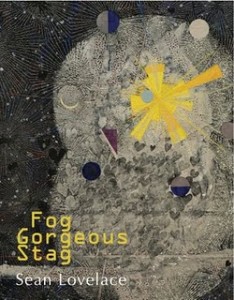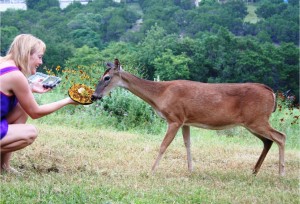Five Questions with Sean Lovelace
 Sophie Rosenblum: Fog Gorgeous Stag weaves language together unexpectedly, breaks forms, and flips punctuation. What first inspired you to play with sentences in these ways?
Sophie Rosenblum: Fog Gorgeous Stag weaves language together unexpectedly, breaks forms, and flips punctuation. What first inspired you to play with sentences in these ways?
Sean Lovelace: First, reading Richard Brautigan. Then reading other poets and poetry, the poet’s attention to the word. I’m always fascinated by what poets can do with language. And certainly I’ve been influenced by writers in the small press community—Matt Bell, Amelia Gray, Blake Butler, etc.—who really crush and bend the word, really understand that sentences do much, much more than simple carry the concrete content. For Fog, there was no other way, for me. I can’t imagine the book being written without a chaos of forms, and word-forms, etc. I mean the primary inspiration is the world around me. As I write this a large earth-moving, loud, angry, fucked up machine is knocking down trees in the forest behind my house. Not sure why. Later I’ll go eat nachos and drink a massive draft Dos Equis and read the paper and right there will be massive killings alongside baseball trades alongside a missing girl from New Jersey and something about Jennifer Lopez’s ass. It’s all pretty Fog to me. It all seems like a shattered sentence. Etc.
SR: Your work seems to value sound and rhythm; what kinds of things do you do to get into the right mindset for writing? Is there anything you recommend your readers do to prepare themselves to read Fog Gorgeous Stag?
SL: I drink a couple cups of oily coffee and try to write in the mornings, when the mind is crackling. Preparation to read the book? Just slow down, is my advice. Drink some beer or take a painkiller and relax with it, I guess. That’s what I’d do. I’d get a 6 pack and a chair down by the creek. And I’d pause and think about things, hopefully. I’d probably throw Cheezits into the creek once in a while, to see the minnows rise up and eat them. Always a cool thing, to feed the fish.
SR: Tell us what makes a perfect plate of nachos.
SL: First thing, screw the plate. Get a nacho bowl, for adequate layering and structural integrity, especially on tertiary layers like guacamole or refried black beans. I have two bowls, and they are easily my most valuable possessions (besides my running shoes). A perfect recipe? Hmm. I eat nachos about 300 days a year, so really switch it up. If I were a nacho newbie, I’d go just a tad off traditional, keep it simple. Mix together guacamole, melted Velveeta, minced garlic, Mrs. Renfros ghost pepper salsa, chili powder, ground cumin, black pepper and chopped cilantro in medium sized mixing bowl. Set aside. Bake (at 450) a shit-load of corn tortillas shards (single layer) in the oven, until golden and crunchy and firm. MUST keep chips crunchy and firm! Turn OFF the oven. Add to chips a mix of shredded sharp cheddar and Monterey jack cheeses. Put back in oven for three minutes. Then remove from oven and add your mixture above, spooning on evenly. Now add a secondary layer of chips (Santitas white corn chips if you have them). Now add a layer of sliced pickled jalapenos and one scoop of sour cream. Dress all of this in dribble of preferred hot sauce (I enjoy habanera based sauces, but I like really spicy nachos) and toss on a scattered handful of fresh, yellow corn. Now go eat.
SR: In your blog it states that you only eat meat that you have hunted. What prompted this decision, and how has it impacted your writing?
 SL: To take a life is a massive, massive thing. There is a big difference between shooting a deer with an arrow and approaching that animal (the same size as me) and dressing, butchering, storing, cooking, eating the animal, a big difference between that and driving up to a drive-thru and getting an aluminum ball of beef. I suppose it’s basically the way of some Native Americans. Respect life. I might also add that venison is free range, organic, without steroids, and lives a full, free life up to the moment of my harvest. I’m not trying to convince others, but it gives me tranquility of mind. So. I doubt this decision affects my writing, but I am sure certain sympathies I have with the natural world are clear. Animals certainly appear in Fog.
SL: To take a life is a massive, massive thing. There is a big difference between shooting a deer with an arrow and approaching that animal (the same size as me) and dressing, butchering, storing, cooking, eating the animal, a big difference between that and driving up to a drive-thru and getting an aluminum ball of beef. I suppose it’s basically the way of some Native Americans. Respect life. I might also add that venison is free range, organic, without steroids, and lives a full, free life up to the moment of my harvest. I’m not trying to convince others, but it gives me tranquility of mind. So. I doubt this decision affects my writing, but I am sure certain sympathies I have with the natural world are clear. Animals certainly appear in Fog.
SR: What can we expect next from Sean Lovelace?
Velveeta! I am only writing about Velveeta for the remainder of 2011. I hope to have a Velveeta book manuscript in the future. Go cheese!

[…] What? You want me to answer even more questions about Fog? That type of thing fascinates you, along with cockroaches and snorting Dexedrine off the top of church pews? Ok, then, I answer questions about Fog for NANO Fiction. […]